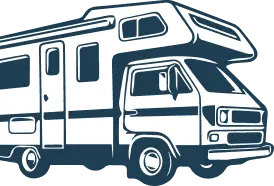
Winter is coming, and while it might be the perfect time to snuggle up by the fireplace, it’s also the time to ensure your RV is ready to brave the cold. Winterizing your RV is essential to protect it from the harsh winter elements and avoid costly repairs. Let’s dive into a detailed, step-by-step guide to keep your RV safe all winter long.
RV winterization is the process of preparing your recreational vehicle for the winter months. This involves draining water systems, adding antifreeze, and taking steps to protect both the exterior and interior from the cold.
Failing to winterize your RV can lead to frozen pipes, burst tanks, and a host of other problems. Proper winterization ensures that your RV stays in good condition, ready for your next adventure when the warm weather returns.
Before you start, gather all necessary tools and materials. You’ll need:
Find a suitable location to work on your RV. Make sure it’s a flat, stable surface with enough space to move around. Having a partner to help can make the process smoother and faster.
Start by turning off the main water supply to your RV. This is crucial to prevent any water from entering the system during the winterization process.
Locate the drain valve for your fresh water tank and open it. Allow all the water to drain out completely. This step is critical to prevent any remaining water from freezing and damaging the tank.
Next, drain the grey and black water tanks. Use the appropriate drain hoses and ensure that all waste is disposed of properly. Cleaning these tanks thoroughly will prevent any unpleasant odors or buildup.
Once drained, clean your fresh water tanks with a mild bleach solution. This helps remove any bacteria or buildup that could cause issues later on.
Sanitize your grey and black water tanks using specialized RV tank cleaners. Follow the instructions on the product to ensure a thorough clean.
Add RV antifreeze to the plumbing system. This is a non-toxic antifreeze designed specifically for RVs. You’ll need to use a water pump converter kit to pump the antifreeze through the system, ensuring all pipes are protected from freezing.
Install a water heater bypass kit to prevent antifreeze from entering the water heater. This saves antifreeze and makes the process more efficient.
Check all windows and doors for any gaps or cracks. Seal these with weatherstripping or caulk to prevent cold air and moisture from entering your RV.
Invest in a high-quality RV cover. This will protect the exterior from snow, ice, and harsh winter winds, keeping it in top condition.
Give the interior of your RV a thorough cleaning. Remove any food, vacuum carpets, and wipe down surfaces to prevent mold and mildew.
Cover furniture with sheets or blankets to protect them from dust and condensation. Ensure all appliances are unplugged and cleaned.
Remove batteries from your RV and store them in a cool, dry place. This prevents them from freezing and extends their lifespan.
Check battery charge levels periodically and recharge as needed. Keeping batteries charged will ensure they’re ready to go when you need them.
Check the tire pressure and inflate to the recommended levels. This helps prevent flat spots and keeps the tires in good condition.
Consider using tire covers and moving the RV slightly every few weeks to prevent flat spots from developing.
Change the oil and filters in both the engine and generator. This helps prevent any potential issues and ensures everything runs smoothly when you’re ready to hit the road again.
Run the engine and generator periodically throughout the winter. This keeps the components lubricated and prevents any problems from developing due to inactivity.
Choose a storage location that is dry, secure, and away from trees or other hazards. Indoor storage is ideal, but a good-quality cover can also provide excellent protection.
Covering your RV with a high-quality cover adds an extra layer of protection against the elements. Ensure the cover is securely fastened to prevent it from blowing away.
Ensure all flammable materials are removed from the RV. Install a smoke detector and check its batteries to ensure they’re working properly.
Consider installing a security system or camera to monitor your RV. Lock all doors and windows and remove any valuables.
Make sure to use enough antifreeze to protect all parts of the plumbing system. Skimping on antifreeze can lead to costly repairs.
Don’t forget to inspect and seal the roof. Leaks can cause significant damage if left unchecked.
Winterizing your RV may seem like a daunting task, but taking the time to do it properly will save you a lot of headaches in the long run. By following this step-by-step guide, you can ensure your RV stays safe and sound all winter long. So, grab your tools, roll up your sleeves, and get ready to winterize your RV like a pro!
You should winterize your RV every year before the first freeze. This ensures that your RV is protected from cold weather damage.
Yes, you can use your RV during the winter, but you’ll need to take additional steps to ensure the plumbing system is protected from freezing temperatures.
Use non-toxic RV antifreeze designed specifically for recreational vehicles. This type of antifreeze is safe for your plumbing system and the environment.
Covering your RV is highly recommended as it protects the exterior from snow, ice, and harsh winter winds.
You’ll know your RV is properly winterized if you’ve followed all the steps in this guide and there’s no water left in the plumbing system. Double-check all seals and covers to ensure everything is secure.

